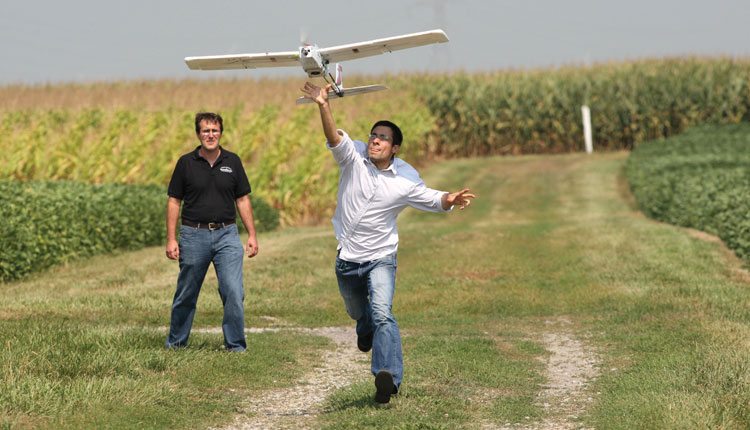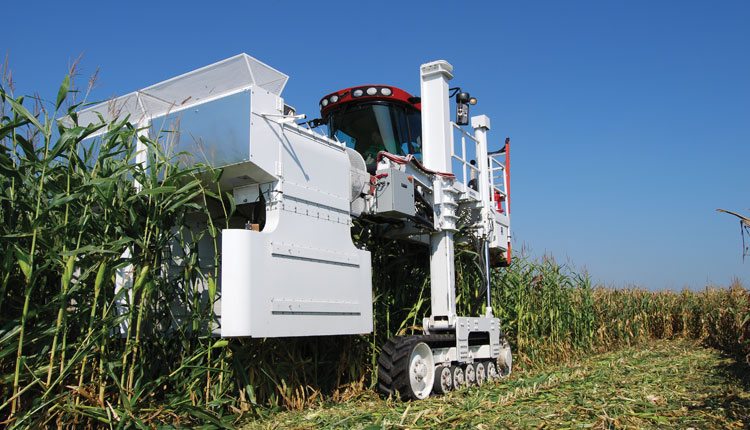Often hard to predict, yield sets the foundation for crop improvement, and researchers are deploying new tools that measure phenotype with the hopes of more accurately predicting yield over more acres, faster.
The ability to predict crop yield is a useful tool, and scientists continue to find new methods for determining how much a farmer will gather at harvest. One method that plant breeders are currently examining is the use of new phenotyping tools, technologies that measure the outward appearance of the plant as an indicator of how much it will produce.
The factors that go into predicting yield are many, so researchers separate out the parts into smaller traits that can be measured more easily.
One agronomist examines plant health and canopy development in soybeans as well as what can be inferred from different canopy images.
Katy Rainey, a Purdue University assistant professor of agronomy, says that technology helps tremendously with her work. Drones take pictures of the canopy and help to quantify its development, allowing her to quickly measure thousands of plots.
“When we try to measure crop performance, it’s not easy to measure yield,” Rainey says. “Yield is an endpoint measurement, and the information is gathered at harvest. If you want additional information about how crop development produces yield, you can only do it with high-throughput techniques. You need to measure many plots quickly.”
Drones Deliver
Drones can measure 2,000 to 5,000 plots in less than an hour. Through the use of drones, new types of data can be collected.
“Measuring phenotype from a drone is indirectly measuring what we’re after,” Rainey says. “Our first target is, what is robust or what can we do no matter what? What can we directly measure that is valuable?”
Even with the use of drone technologies, inspecting plants up close is still needed. Rainey’s students previously used around 70,000 images from the ground to aid in this endeavor.
Drones are not the only platform for collecting new data. Drones are limited by a resolution of 4 centimeters, so Rainey also employs vehicles called phenomobiles. These can be hi-boy tractors or even golf carts that are fitted with several sensors that can measure phenotypes. Because the phenomobiles are so close to the crop, their images can be more accurate than the drones.
Along with the images, hyperspectral reflectance sensors are used. These sensors can detect wavelengths of light that reflect back to the phenotyping platform, whether that’s a drone, tractor or aircraft. The sensor divides the wavelengths into narrow bands and quantifies each one. These wavelengths provide insight into factors such as plant temperature and chlorophyll content.
Even though she focuses on soybean breeding, Rainey collaborates with several others in different disciplines. Engineers work with the hyperspectral sensors. Agricultural and biological engineers operate the drone platform and contribute expertise in remote sensing. They also analyze data from drone images and program systems so that information the researchers are seeking can be extracted from the geographic information systems.
While Rainey measures phenotypic traits in the field because she is working in the same environment as farmers, the research could also be done in growth chambers or greenhouses. Soybean seeds can be phenotyped using near infrared reflectance (NIR), an industry-wide measurement that provides real time results. The protein and oil content are collected and an algorithm developed for a training set.
Rainey notes that her research could be most applicable for Indiana and other “I” states, and that the ability to predict yield using phenotypes in other environments might be limited.
“In a different zone of adaptation where you have different planting and harvesting dates and production systems, yield predictions may be different,” Rainey says.
Although these applications are five to 10 years from the farmer’s field, Rainey says that service providers are already measuring crop performance using sensors as part of precision agriculture. There is some uncertainty as to regulations surrounding drones, Rainey notes, but in the long run, being able to predict yield through phenotyping can save time and labor and accomplish tasks more efficiently, accurately and precisely.
“We can convert a subjective opinion to a quantitative measurement,” she says. “We’re trying something new that was impossible previously.”
Businesses such as DuPont Pioneer also are researching how phenotype can predict yield. Neil Hausmann, senior research manager for breeding technologies, says that the most expensive aspect of product development is measuring yield during field testing of its hybrids.
“Variability in the yield of hybrids across time and space necessitates multi-year and multi-environment testing,” Hausmann says. “Accurate yield prediction could significantly reduce the time needed to develop products, thus getting new and improved varieties into the hands of our customers more rapidly.”
Precision Phenotyping
Hausmann points to three areas to demonstrate how Pioneer works with precision phenotyping: carefully controlled field trials, precision phenotyping technologies and a modeling system known as EnClass.
During carefully managed field trials, variations in yield potential and yield stability are measured. Hausmann shares that Pioneer uses several managed testing environments in which they precisely control aspects such as irrigation, chemical applications and fertilization. Situations that farmers could encounter in the field such as drought, nitrogen deficiency or disease can be reproduced. In these simulations, genetic lines in the breeding pipeline are monitored to measure how they react. Plant phenotypes that explain genetic and environmental aspects and determine yield are then measured.
Technologies that precisely measure phenotype are used in field trials to directly measure traits that contribute to yield. For example, ear photometry technology is used in corn to measure each ear’s number of kernels, rows and rings. This technology can accurately predict yield on an ear basis.
From this data, researchers develop models to predict hybrid performance. Disease, interaction between plants and genetic responses to environmental stresses can also be measured, and as in Rainey’s research, this data can be collected quickly in a high-throughput system.
According to Pioneer, the ear photometry system enables better prediction of product performance and allows for targeted selection of genetics showing adaptation to wide ranges of growing environments. It is a key technology used in the continued development of many Pioneer brand corn products.
Additionally, Pioneer uses EnClass — a system that uses crop modeling and historical weather data to estimate long-term weather environments at certain locations — to help phenotype plants. This paints a picture of how products will respond to varying environmental conditions.
“These models are based on scientific understanding of environmental and physiological factors and how they combine to impact yield,” Hausmann says.
This information guides decisions on bringing products to market, seed quantities needed for sales and identifying ways customers can use a new product with the most success.
Hausmann says it also helps researchers understand the strengths and weaknesses of each product, guiding plant breeders in their efforts to continually improve the product pipeline.
Another tool used to measure performance is the Pioneer-developed Boreas wind machine, which simulates strong winds with the potential to devastate fields and yields. With the ability to create winds exceeding 100 miles per hour, the Boreas wind machine gives researchers the opportunity to see how well Pioneer corn hybrids hold up under intense pressure from wind storms.
According to Pioneer estimates, wind-related damage can cost corn producers in North America more than $1 billion annually.
“We use this precision phenotyping tool to screen our genetic lines, filtering out hybrids that are likely to snap, root or stalk lodge,” explains Hausmann. “We have documented specific impact of the implementation of the Boreas wind machines on the improvement in our product development pipeline.”
The wind machine helps researchers better simulate rare or difficult-to-reproduce field conditions. Prior to the Boreas wind machine, scientists had to wait for unpredictable natural storms or conduct mechanical push tests. Now, they are able to precisely control the wind factor.
Precision phenotyping tools, such as drones, ear photometry the EnClass system, Boreas wind machine and others have real application for seed retailers and marketers.
“These are important tools because we can explicitly measure and communicate the strengths and weaknesses of our products as well as deliver products with improved yield stability and agronomic characterization,” Hausmann says. “This should provide competitive products with improved positioning and service support.”















